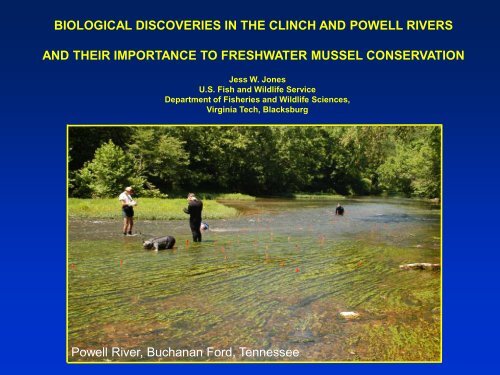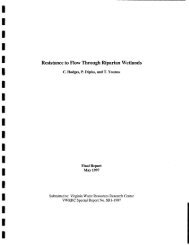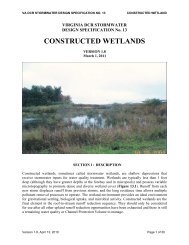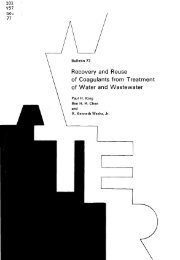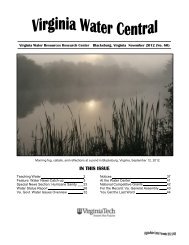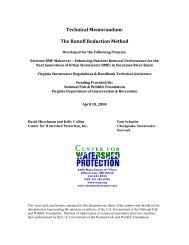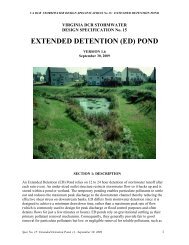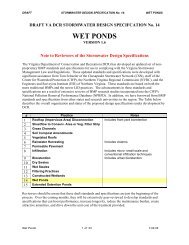biological discoveries in the clinch and powell rivers - Virginia Water ...
biological discoveries in the clinch and powell rivers - Virginia Water ...
biological discoveries in the clinch and powell rivers - Virginia Water ...
Create successful ePaper yourself
Turn your PDF publications into a flip-book with our unique Google optimized e-Paper software.
BIOLOGICAL DISCOVERIES IN THE CLINCH AND POWELL RIVERS<br />
AND THEIR IMPORTANCE TO FRESHWATER MUSSEL CONSERVATION<br />
Jess W. Jones<br />
U.S. Fish <strong>and</strong> Wildlife Service<br />
Department of Fisheries <strong>and</strong> Wildlife Sciences,<br />
Virg<strong>in</strong>ia Tech, Blacksburg<br />
Powell River, Buchanan Ford, Tennessee
Biological Discoveries <strong>in</strong> <strong>the</strong> Cl<strong>in</strong>ch <strong>and</strong> Powell Rivers <strong>and</strong> Their Importance to<br />
Freshwater Mussel Conservation. Jess W. Jones, FWS<br />
The mussels, snails, fishes, crayfishes <strong>and</strong> aquatic <strong>in</strong>sects of <strong>the</strong> Cl<strong>in</strong>ch <strong>and</strong> Powell <strong>rivers</strong><br />
are recognized as one of <strong>the</strong> most <strong>biological</strong>ly diverse freshwater faunas <strong>in</strong> <strong>the</strong> world,<br />
especially at temperate latitudes. The fauna conta<strong>in</strong>s 18 federally endangered mussels<br />
<strong>and</strong> 5 federally endangered or threatened fish, <strong>the</strong> highest concentration of aquatic listed<br />
species <strong>in</strong> <strong>the</strong> country. While <strong>the</strong> mussel fauna has been studied <strong>in</strong>termittently over <strong>the</strong><br />
past 30 years, recent field <strong>and</strong> laboratory <strong>in</strong>vestigations highlight several important<br />
<strong>discoveries</strong>: (1) <strong>the</strong> functional role of mussels <strong>in</strong> river ecosystems <strong>and</strong> <strong>the</strong>ir reproductive<br />
life cycle is more complex than orig<strong>in</strong>ally thought, with <strong>the</strong> juvenile stage be<strong>in</strong>g especially<br />
vulnerable to various commonly occurr<strong>in</strong>g contam<strong>in</strong>ants, (2) endangered mussels <strong>in</strong> each<br />
river are less abundant <strong>and</strong> more geographically conf<strong>in</strong>ed than previously thought, <strong>and</strong> <strong>in</strong><br />
most cases, <strong>the</strong>se are ei<strong>the</strong>r <strong>the</strong> last rema<strong>in</strong><strong>in</strong>g or best population of <strong>the</strong> species, <strong>and</strong> (3)<br />
patterns of population decl<strong>in</strong>e, stability <strong>and</strong> <strong>in</strong>crease now show that mussel abundance is<br />
high <strong>and</strong> <strong>in</strong>creas<strong>in</strong>g only <strong>in</strong> <strong>the</strong> Tennessee section of <strong>the</strong> Cl<strong>in</strong>ch River, whereas mussel<br />
abundance is low <strong>and</strong> decl<strong>in</strong><strong>in</strong>g <strong>in</strong> large sections of <strong>the</strong> Cl<strong>in</strong>ch River <strong>in</strong> Virg<strong>in</strong>ia <strong>and</strong><br />
throughout <strong>the</strong> entire Powell River. For example, current monitor<strong>in</strong>g data <strong>in</strong>dicate that<br />
mussel populations have decl<strong>in</strong>ed precipitously <strong>in</strong> a ~50 mile section of <strong>the</strong> Cl<strong>in</strong>ch River<br />
from St. Paul downstream to Speers Ferry. Ongo<strong>in</strong>g efforts to protect riparian habitat,<br />
restore ab<strong>and</strong>oned m<strong>in</strong>e l<strong>and</strong>s, control pollution, <strong>and</strong> identify sources of contam<strong>in</strong>ants are<br />
be<strong>in</strong>g implemented to improve <strong>the</strong> water <strong>and</strong> habitat conditions of <strong>the</strong>se two <strong>rivers</strong>. A<br />
large collaborative effort is urgently needed to protect <strong>and</strong> restore <strong>the</strong>se <strong>rivers</strong> for future<br />
generations.
Biological Discoveries & Their Importance to Conservation<br />
Functional role of mussels <strong>in</strong><br />
river ecosystems<br />
Mussel life cycle – juvenile stage<br />
Population trends<br />
Importance to conservation<br />
Cl<strong>in</strong>ch River, Wallen Bend, Tennessee<br />
Photo by Jack Looney
Mollusks <strong>in</strong>clude both<br />
snails <strong>and</strong> mussels which<br />
are a significant<br />
component of <strong>the</strong> fauna<br />
<strong>in</strong> <strong>rivers</strong> like <strong>the</strong> Cl<strong>in</strong>ch<br />
River<br />
Photo by Jack Looney
Role of Freshwater Mussels <strong>in</strong> River Ecosystems<br />
Energy transfer – filter feed<strong>in</strong>g<br />
Nutrient cycl<strong>in</strong>g – filter feed<strong>in</strong>g<br />
Bio-deposition – excretion of waste<br />
Ecosystem eng<strong>in</strong>eer<strong>in</strong>g – modifications<br />
to stream bottom habitat<br />
Bioturbation – burrow<strong>in</strong>g, rework<strong>in</strong>g <strong>the</strong><br />
stream bottom sediments<br />
Mussels provide multiple ecosystem services<br />
Mussel siphon<strong>in</strong>g & filter<strong>in</strong>g water
Carbo, VA<br />
Big Stone Gap, VA<br />
●<br />
●<br />
●<br />
Clevel<strong>and</strong><br />
Isl<strong>and</strong>s<br />
Freshwater mussel monitor<strong>in</strong>g sites <strong>in</strong> <strong>the</strong> Cl<strong>in</strong>ch <strong>and</strong> Powell <strong>rivers</strong>, TN & VA<br />
Mussel monitor<strong>in</strong>g sites, lower Cl<strong>in</strong>ch River, TN
Brooks Isl<strong>and</strong>-Frost Ford<br />
Little E<br />
Little E<br />
Frost Ford<br />
Frost Ford<br />
Shoal Complex
Brooks Isl<strong>and</strong>-Frost Ford<br />
Endangered mussels:<br />
● Dromedary pearly mussel >20,000<br />
● Crack<strong>in</strong>g pearlymussel >8,000<br />
● Fanshell >3,000<br />
● Cumberl<strong>and</strong> combshell >10,000<br />
● Oyster mussel >800,000<br />
Endangered fish:<br />
● Pygmy madtom<br />
● Slender chub<br />
Slender chub<br />
Pygmy madtom
Mussel Filtration Rates - Cl<strong>in</strong>ch River<br />
• 1 mussel can filter ~0.5 gallon/hr.<br />
• 1 mussel = 12 gallons/day<br />
• Brooks-Frost Ford > 1 million mussels<br />
• <strong>Water</strong> filtered/day = 12,000,000 gallons<br />
• In summer, <strong>the</strong> river volume can be filtered <strong>in</strong> a couple<br />
river miles
MUSSEL LIFE HISTORY – THE OLD PARADIGM<br />
Mussels spawn throughout <strong>the</strong> spr<strong>in</strong>g <strong>and</strong> summer<br />
The larvae (glochidia) are obligate parasites on fish<br />
Larvae require 2-3 weeks to metamorphose to <strong>the</strong> juvenile stage
Mussel Fish Hosts
Oyster Mussel Epioblasma capsaeformis Cl<strong>in</strong>ch River
MICROLURES
Oyster Mussel Goes Fish<strong>in</strong>g!<br />
Captured fish host<br />
Releas<strong>in</strong>g fish host <strong>in</strong>fested with larvae
MUSSEL GLOCHIDIA
GLOCHIDIA ATTACHED TO GILL LAMELLAE
250 m<br />
NEWLY METAMORPHOSED JUVENILES
Ammonia Toxicity (mgNH 3 -N/L)<br />
Species Mean LC50 Citation<br />
Glochidia<br />
Ra<strong>in</strong>bow mussel (24-h) 0.284 Goudreau et al. 1993<br />
Ra<strong>in</strong>bow mussel (96-h) 0.110 Cherry et al. 2005<br />
Juveniles<br />
Pocketbook (96-h) 0.127- 0.165 Newton et al. 2003<br />
Wavy-rayed (96-h) 0.26 Mummert et al. 2003<br />
Ra<strong>in</strong>bow mussel (96-h) 0.12 Mummert et al. 2003<br />
Ra<strong>in</strong>bow mussel (96-h) 0.38 Cherry et al. 2005<br />
Toxicity at
Recent Ammonia Levels<br />
(Johnson et al. 2007)<br />
Location<br />
IW NH3-N(mg/L)<br />
Cl<strong>in</strong>ch River<br />
Ft. Blackmore 0.37- 0.68<br />
Indian Creek 1.60- 2.06<br />
Powell River<br />
Jonesville 1.14
Environmental Stressors <strong>and</strong> Mussel Decl<strong>in</strong>es<br />
SEDIMENTATION<br />
AGRICULTURE<br />
MINING<br />
TOXIC SPILLS
Carbo, VA<br />
Big Stone Gap, VA<br />
●<br />
●<br />
●<br />
Clevel<strong>and</strong><br />
Isl<strong>and</strong>s<br />
Freshwater mussel Mussel monitor<strong>in</strong>g monitor<strong>in</strong>g sites sites, <strong>in</strong> <strong>the</strong> middle Cl<strong>in</strong>ch Cl<strong>in</strong>ch <strong>and</strong> Powell River, <strong>rivers</strong>, VA TN & VA
Middle Cl<strong>in</strong>ch River – Longterm Trend Monitor<strong>in</strong>g, 1979-2009<br />
Sites & River Mile (RM)<br />
Speers Ferry, VA (211.1)<br />
Pendleton Isl<strong>and</strong>, VA (226.7)<br />
Simones Isl<strong>and</strong>, VA (235.1)<br />
Quantitative sampl<strong>in</strong>g for mussels
Middle Cl<strong>in</strong>ch River, VA 1979-2009<br />
30<br />
Mussels per m 2<br />
25<br />
20<br />
15<br />
10<br />
5<br />
P < 0.01<br />
0<br />
1975 1980 1985 1990 1995 2000 2005 2010<br />
At <strong>in</strong>vestigated sites, total mussel abundance has decreased by 80%.
Pendleton Isl<strong>and</strong> Mussel Preserve, VA (RM 226.7)<br />
Historically, best site on Cl<strong>in</strong>ch River<br />
● Discovered <strong>in</strong> 1977-1978 by TVA biologists<br />
● Purchased by TNC <strong>in</strong> 1983<br />
43 species documented<br />
Populations now <strong>in</strong> severe decl<strong>in</strong>e
Right Descend<strong>in</strong>g Channel
Left Descend<strong>in</strong>g Channel
Pendleton Isl<strong>and</strong>, VA 1979-2009<br />
30<br />
Mussels per m 2<br />
25<br />
20<br />
15<br />
10<br />
5<br />
P < 0.001<br />
0<br />
1975 1980 1985 1990 1995 2000 2005 2010 2015<br />
Total mussel abundance has decl<strong>in</strong>ed by 96%.
Pendleton Isl<strong>and</strong>: Lost Ecosystem Services<br />
Available Habitat:<br />
Left Channel = 16,000 m 2<br />
Right Channel = 16,000 m 2<br />
O<strong>the</strong>r Areas = 8,000 m 2<br />
Total Habitat = 40,000 m 2<br />
Historical Mussel Abundance:<br />
25 m 2 of mussels<br />
40,000 m 2 of habitat<br />
Total = 1 million mussels<br />
Filtration Services Lost:<br />
1 mussel can filter 12 gallons per day<br />
Historically, 12 million gallons filtered per day<br />
Today, 480,000 gallons filtered per day<br />
96% decl<strong>in</strong>e of site capacity
Middle Cl<strong>in</strong>ch River, VA<br />
Guest River<br />
St. Paul, VA<br />
RM 252<br />
Pendleton Isl<strong>and</strong> RM 226<br />
Cl<strong>in</strong>chport RM 213
Mussel Distribution <strong>and</strong> Abundance<br />
Range contractions for<br />
endangered mussels<br />
<strong>in</strong> both <strong>rivers</strong><br />
Last or best rema<strong>in</strong><strong>in</strong>g<br />
populations of most<br />
endangered mussels<br />
Decl<strong>in</strong>es <strong>in</strong> mussel abundance:<br />
- Virg<strong>in</strong>ia section of Cl<strong>in</strong>ch River<br />
- Throughout entire Powell River<br />
Endangered monkeyface mussels, Powell River
MUSSEL PROPAGATION FACILITIES<br />
● Two mussel hatchery facilities <strong>in</strong> Virg<strong>in</strong>ia<br />
Both focus on restor<strong>in</strong>g mussel populations<br />
<strong>in</strong> <strong>the</strong> Cl<strong>in</strong>ch <strong>and</strong> Powell Rivers<br />
Aquatic Wildlife Conservation Center,<br />
VDGIF, Marion<br />
Freshwater Mollusk Conservation Center,<br />
Virg<strong>in</strong>ia Tech, Blacksburg
MUSSEL PROPAGATION & RESTORATION
Restoration of Mussel Populations<br />
Tagged adult mussels<br />
Releas<strong>in</strong>g adult mussels
Biological Discoveries <strong>and</strong> Their Importance<br />
to Conservation <strong>in</strong> <strong>the</strong> Cl<strong>in</strong>ch <strong>and</strong> Powell Rivers<br />
Due to <strong>the</strong>ir complex life cycle, especially <strong>the</strong> juvenile stage,<br />
improv<strong>in</strong>g water quality <strong>and</strong> habitat conditions is critical to <strong>the</strong><br />
survival of freshwater mussels<br />
Mussels play important roles <strong>in</strong> river ecosystems that benefit<br />
wildlife <strong>and</strong> humans<br />
Survival of more than a dozen mussel species is now dependent<br />
on rema<strong>in</strong><strong>in</strong>g populations <strong>in</strong> <strong>the</strong> Cl<strong>in</strong>ch <strong>and</strong> Powell Rivers<br />
Conservation efforts must cont<strong>in</strong>ue to focus on reduc<strong>in</strong>g <strong>and</strong><br />
elim<strong>in</strong>at<strong>in</strong>g sources of pollution
Questions<br />
Sp<strong>in</strong>y river snail tend<strong>in</strong>g an<br />
egg clutch <strong>in</strong> <strong>the</strong> Cl<strong>in</strong>ch River


